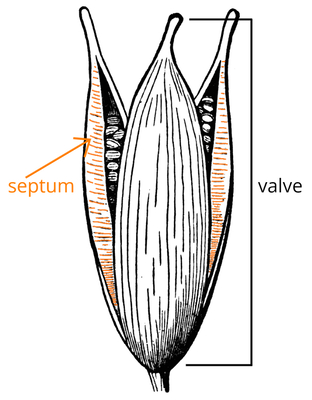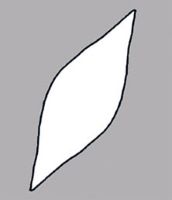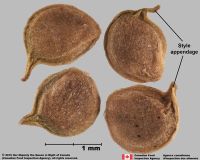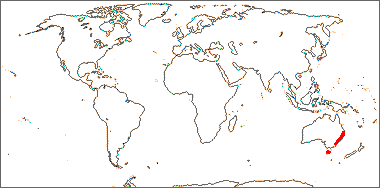Family name: Blandfordiaceae R. Dahlgren & Clifford
Synonym(s): [none]
Common name(s): Christmas bells family
*Number of genera/species: 1/4
List of genera records in GRIN-Global
seed
Fruit a septicidalsepticidal:
type of capsular dehiscence, opening longitudinally by separating between the septa of adjacent carpels
 winged capsulecapsule:
winged capsulecapsule:
a dry, dehiscent fruit derived from a compound ovary , 55–90 mm long, fusiformfusiform:
, 55–90 mm long, fusiformfusiform:
spindle-shaped; broadest at the middle and tapering at both ends to trigonoustrigonous:
to trigonoustrigonous:
3D shape—having three faces that meet at distinct angles; triangular in outline
, tereteterete:
approximately circular in cross section; width and thickness approximately equal
 to triangulartriangular:
to triangulartriangular:
2D shape—three relatively straight sides with distinct corners; more angular than teardrop-shaped in transection, stylestyle:
in transection, stylestyle:
in a flower, the narrow and elongated part of the pistil between the stigma and the ovary; sometimes persisting in fruit persistent, many seeded. Pericarppericarp:
persistent, many seeded. Pericarppericarp:
fruit wall or fruit coat
brown, chartaceouschartaceous:
papery, papyraceous
.
Seeds linearlinear:
(shape) long, narrow, and uniform in width; (of embryo) embryo is straight and much longer than wide to oblongoblong:
to oblongoblong:
2D shape—much longer than broad with nearly parallel sides, corners are rounded , polygonalpolygonal:
, polygonalpolygonal:
angular
or falcatefalcate:
shaped like a scythe or sickle , 5–6 mm long. Seed coat brown, papillatepapillate:
, 5–6 mm long. Seed coat brown, papillatepapillate:
surface relief—bearing minute, distinct, broad-based projections, tapering to a rounded apex , and densely covered with colorless hairs (appearing felted).
, and densely covered with colorless hairs (appearing felted).
Embryo linearlinear:
(shape) long, narrow, and uniform in width; (of embryo) embryo is straight and much longer than wide , curvedcurved:
, curvedcurved:
(of embryo) linear embryo is curved into an arch or horseshoe with the ends far apart or straight, about 1/2 the length of the seed.
or straight, about 1/2 the length of the seed.
Endosperm copious, starchless.
| Fruit | |
| Type | septicidalsepticidal: type of capsular dehiscence, opening longitudinally by separating between the septa of adjacent carpels  capsulecapsule: capsulecapsule:a dry, dehiscent fruit derived from a compound ovary  |
| Size range | 55–60 mm long |
| Shape(s) | fusiformfusiform: spindle-shaped; broadest at the middle and tapering at both ends  , trigonoustrigonous: , trigonoustrigonous:3D shape—having three faces that meet at distinct angles; triangular in outline |
| Texture | chartaceouschartaceous: papery, papyraceous |
| Color(s) | brown |
| Unique features | Paperypapery: texture—papyraceous, chartaceous; very thin, pliable, and readily torn; like paper , winged, fusiformfusiform: spindle-shaped; broadest at the middle and tapering at both ends  to trigonoustrigonous: to trigonoustrigonous:3D shape—having three faces that meet at distinct angles; triangular in outline capsulescapsule: a dry, dehiscent fruit derived from a compound ovary  with persistent stylesstyle: with persistent stylesstyle:in a flower, the narrow and elongated part of the pistil between the stigma and the ovary; sometimes persisting in fruit  . . |
| Seed | |
| Size range | 5–6 mm long |
| Shape(s) | ellipsoidellipsoid: 3D shape—elliptic , linearlinear: (shape) long, narrow, and uniform in width; (of embryo) embryo is straight and much longer than wide  , oblongoblong: , oblongoblong:2D shape—much longer than broad with nearly parallel sides, corners are rounded  , falcatefalcate: , falcatefalcate:shaped like a scythe or sickle  , polygonalpolygonal: , polygonalpolygonal:angular |
| Surface relief | papillatepapillate: surface relief—bearing minute, distinct, broad-based projections, tapering to a rounded apex  ; densely covered with colorless hairs ; densely covered with colorless hairs |
| Color(s) | brown |
| Unique features | Brown seeds densely covered with colorless hairs. |
| Other | |
| Embryo | linearlinear: (shape) long, narrow, and uniform in width; (of embryo) embryo is straight and much longer than wide  , curvedcurved: , curvedcurved:(of embryo) linear embryo is curved into an arch or horseshoe with the ends far apart  or straight, about 1/2 the length of the seed or straight, about 1/2 the length of the seed |
| Nutritive tissue | endosperm copious, starchless |
Eastern Australia.

Distribution map courtesy of Angiosperm Phylogeny Website.
Baskin and Baskin 2021Baskin and Baskin 2021:
Baskin C and Baskin J. 2021. Relationship of the lateral embryo (in grasses) to other monocot embryos: A status up-grade. Seed Science Research 31 (3): 199-210. doi:10.1017/S0960258521000209; Dahlgren et al. 1985Dahlgren et al. 1985:
Dahlgren RMT, Clifford HT, and Yeo PF. 1985. The families of the monocotyledons: structure, evolution, and taxonomy. Springer-Verlag, Berlin. 520 pp.; Kirkbride et al. 2006Kirkbride et al. 2006:
Kirkbride JH, Jr, Gunn CR, and Dallwitz MJ. 2006. Family guide for fruits and seeds, vers. 1.0. Accessed September 2020-January 2022. URL: https://nt.ars-grin.gov/seedsfruits/keys/frsdfam/index.cfm .; Kubitzki et al. 1990+Kubitzki et al. 1990+:
Kubitzki K et al., eds. 1990+. The families and genera of vascular plants. 7+ vols. Berlin etc.; PlantNET 2021+PlantNET 2021+:
PlantNET (The NSW Plant Information Network System). 2021+. Royal Botanic Gardens and Domain Trust, Sydney. Accessed January 2021–March 2024. URL: https://plantnet.rbgsyd.nsw.gov.au; Stevenson and Loconte 1995Stevenson and Loconte 1995:
Stevenson DW and Loconte H. 1995. A cladistic analysis of monocot families. In: Rudall PJ, Cribb PJ, Cutler DF, and Humphries CJ, eds. Monocotyledons: Systematics and Evolution. Royal Botanic Gardens, Kew.; Takhtajan 2009Takhtajan 2009:
Takhtajan A. 2009. Flowering plants: Second edition. Springer Nature, Switzerland. 871 pp.; Watson and Dallwitz 1992+Watson and Dallwitz 1992+:
Watson L and Dallwitz MJ. 1992+. The families of flowering plants: descriptions, illustrations, identification, and information retrieval. Version: 6th Accessed September 2020-September 2022. URL: delta-intkey.com
*The number of genera and species is based on Christenhusz and Byng 2016Christenhusz and Byng 2016:
Christenhusz MJM and Byng JW. 2016. The number of known plant species in the world and its annual increase. Phytotaxa 261 (3): 201-217. https://doi.org/10.11646/phytotaxa.261.3.1, which may differ from the number of genera in GRIN-Global.